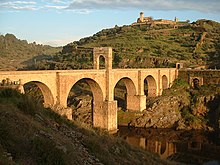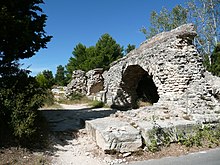Ancient Roman engineering

The
Roman roads

Roman roads were constructed to be immune to floods and other environmental hazards. Some roads built by the Romans are still in use today.
There were several variations on a standard Roman road. Most of the higher quality roads were composed of five layers. The bottom layer, called the pavimentum, was one inch thick and made of mortar. Above this were four strata of masonry. The layer directly above the pavimentum was called the statumen. It was one foot thick, and was made of stones bound together by cement or clay.
Above that, there was the rudens, which was made of ten inches of rammed concrete. The next layer, the nucleus, was made of twelve to eighteen inches of successively laid and rolled layers of concrete. Summa crusta of silex or lava polygonal slabs, one to three feet in diameter and eight to twelve inches thick, were laid on top of the rudens. The final upper surface was made of concrete or well-smoothed and fitted flint.
Generally, when a road encountered an obstacle, the Romans preferred to engineer a solution to the obstacle rather than redirecting the road around it: bridges were constructed over all sizes of waterway; marshy ground was handled by the construction of raised causeways with firm foundations; hills and outcroppings were frequently cut or tunneled through rather than avoided (the tunnels were made with square hard rock block).
Aqueducts

A thousand cubic metres (260,000 US gal) of water were brought into Rome by eleven different aqueducts each day. Per capita water usage in ancient Rome matched that of modern-day cities like New York City or modern Rome. Most water was for public use, such as baths and sewers. De aquaeductu is the definitive two volume treatise on 1st century aqueducts of Rome, written by Frontinus.
The aqueducts could stretch from 10–100 km (10–60 mi) long, and typically descended from an elevation of 300 m (1,000 ft) above sea level at the source, to 100 m (330 ft) when they reached the reservoirs around the city. Roman engineers used inverted siphons to move water across a valley if they judged it impractical to build a raised aqueduct. The Roman legions were largely responsible for building the aqueducts. Maintenance was often done by slaves.[2]
The Romans were among the first civilizations to harness the power of water. They built some of the first
They were also skilled in mining, building aqueducts needed to supply equipment used in extracting metal ores, e.g.
Bridges

Roman bridges were among the first large and lasting bridges ever built. They were built with stone, employing the arch as basic structure. Most utilized concrete as well. Built in 142 BC, the Pons Aemilius, later named Ponte Rotto (broken bridge) is the oldest Roman stone bridge in Rome, Italy.
The biggest Roman bridge was
An example of temporary military bridge construction is the two Caesar's Rhine bridges.
Dams
The Romans built many
Several earthen dams are known from Britain, including a well-preserved example from Roman Lanchester,
Architecture

The buildings and architecture of Ancient Rome were impressive. The Circus Maximus, for example, was large enough to be used as a stadium. The Colosseum also provides an example of Roman architecture at its finest. One of many stadiums built by the Romans, the Colosseum exhibits the arches and curves commonly associated with Roman buildings.
The Pantheon in Rome still stands a monument and tomb, and the Baths of Diocletian and the Baths of Caracalla are remarkable for their state of preservation, the former still possessing intact domes. Such massive public buildings were copied in numerous provincial capitals and towns across the empire, and the general principles behind their design and construction are described by Vitruvius writing at the turn of millennium in his monumental work De architectura.
The technology developed for the baths was especially impressive, especially the widespread use of the hypocaust for one of the first types of central heating developed anywhere. That invention was used not just in the large public buildings, but spread to domestic buildings such as the many villas which were built across the Empire.
Materials
The most common materials used were brick, stone or masonry, cement, concrete and marble. Brick came in many different shapes. Curved bricks were used to build columns, and triangular bricks were used to build walls.
Marble was mainly a decorative material. Augustus once boasted that he had turned Rome from a city of bricks to a city of marble. The Romans had originally brought marble over from Greece, but later found their own quarries in northern Italy.
Cement was made of hydrated lime (calcium oxide) mixed with sand and water. The Romans discovered that substituting or supplementing the sand with a pozzolanic additive, such as volcanic ash, would produce a very hard cement, known as hydraulic mortar or hydraulic cement. They used it widely in structures such as buildings, public baths and aqueducts, ensuring their survival into the modern era.
Mining

The Romans were the first to exploit mineral deposits using advanced technology, especially the use of
Such methods could be very effective in opencast mining, but fire-setting was very dangerous when used in underground workings. They were made redundant with the introduction of
At alluvial mines, they applied their
Military engineering
Engineering was also institutionally ingrained in the Roman military, who constructed forts, camps, bridges, roads, ramps, palisades, and siege equipment amongst others. One of the most notable examples of military bridge-building in the Roman Republic was
The army was also closely involved in
Power technology


Water wheel technology was developed to a high level during the Roman period, a fact attested both by
Twelve kilometers north of Arles, at Barbegal, near
The
The
Further crank and connecting rod mechanisms, without gear train, are archaeologically attested for the 6th-century AD water-powered stone sawmills at
A complex of mills also existed on the
The site thus resembles
Many other sites are reported from across the Roman Empire, although many remain unexcavated.
See also
- List of Roman watermills
- Roman agriculture
- Roman metallurgy
- Roman mining
- Roman technology
References
- ^ Duruy, Victor, and J. P. Mahaffy. History of Rome and the Roman People: From Its Origin to the Establishment of the Christian Empire. London: K. Paul, Trench & Co, 1883. Page 17
- ^ Vinati, Simona and Piaggi, Marco de. “Roman Aqueducts, Aqueducts in Rome.” Rome.info. Web. 5/1/2012
- ^ Ville d'Histoire et de Patrimonie Archived 2013-12-06 at the Wayback Machine
- ^ "La meunerie de Barbegal". Archived from the original on 2007-01-17. Retrieved 2010-06-29.
- ^ Ritti, Grewe & Kessener 2007, p. 140
- ^ Ritti, Grewe & Kessener 2007, p. 161
- ^ Ritti, Grewe & Kessener 2007, pp. 139–141
- ^ Ritti, Grewe & Kessener 2007, pp. 149–153
- ^ Wilson 2002, p. 16
- ^ Örjan Wikander, 'Water-mills in Ancient Rome' Opuscula Romana XII (1979), 13–36.
- ^ Örjan Wikander, 'Water-mills in Ancient Rome' Opuscula Romana XII (1979), 13–36.
Bibliography
- Davies, Oliver (1935). Roman Mines in Europe. Oxford.
{{cite book}}: CS1 maint: location missing publisher (link) - Healy, A.F. (1999). Pliny the Elder on Science and Technology. Oxford: Clarendon.
- Hodge, T. (2001). Roman aqueducts and Water supply (2nd ed.). Duckworth.
- Ritti, Tullia; Grewe, Klaus; Kessener, Paul (2007), "A Relief of a Water-powered Stone Saw Mill on a Sarcophagus at Hierapolis and its Implications", Journal of Roman Archaeology, 20: 138–163, S2CID 161937987
- Smith, Norman (1972). A History of Dams. Citadel Press.
- S2CID 154629776
Further reading
- Cuomo, Serafina. 2008. "Ancient written sources for engineering and technology." In The Oxford handbook of engineering and technology in the classical world. Edited by John P. Oleson, 15–34. New York: Oxford Univ. Press.
- Greene, Kevin. 2003. "Archaeology and technology." In A companion to archaeology. Edited by John L. Bintliff, 155–173. Oxford: Blackwell.
- Humphrey, John W. 2006. Ancient technology. Westport, CT: Greenwood.
- McNeil, Ian, ed. 1990. An encyclopedia of the history of technology. London: Routledge.
- Oleson, John P., ed. 2008. The Oxford handbook of engineering and technology in the classical world. New York: Oxford Univ. Press.
- Rihll, Tracey E. 2013. Technology and society in the ancient Greek and Roman worlds. Washington, DC: American Historical Society.
- White, Kenneth D. 1984. Greek and Roman technology. Ithaca, NY: Cornell Univ. Press.
